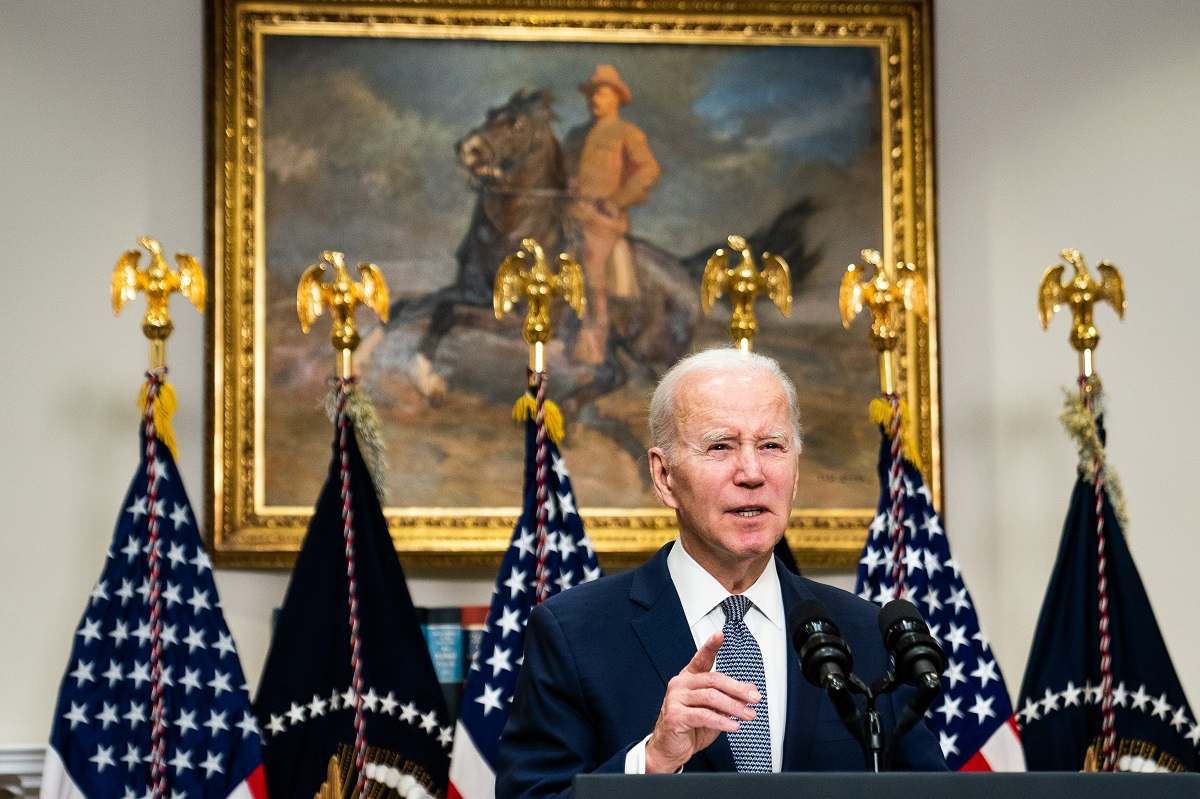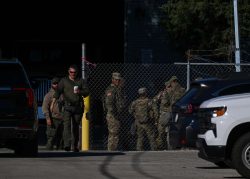
President Joe Biden delivers remarks on the banking system in the Roosevelt Room of the White House in Washington, D.C., on March 13, 2023.
13:02 JST, March 14, 2023
Washington’s banking rescue had a rocky start Monday on Wall Street, as the government’s response to the collapse of Silicon Valley Bank failed to quell doubts about the health of some midsize banks and left investors debating whether the Federal Reserve would be forced to change course in its fight against inflation.
The day began with President Biden at the White House seeking to calm fears of a banking crisis before leaving Washington for a California swing.
“Americans can have confidence that the banking system is safe. Your deposits will be there when you need them,” the president said in midmorning remarks from the Roosevelt Room.
In Silicon Valley, relieved customers lined up outside SVB branches to withdraw funds they had feared would be lost. Depositors at the bank’s Menlo Park location said they waited up to two hours to get their money in cashier’s checks. The only evidence of the failed bank’s new owners was a Federal Deposit Insurance Corp. new release taped to the door.
On Wall Street, bank stocks were ravaged, with regional institutions hit hardest. First Republic Bank, another midsize bank, saw its share price fall nearly 80 percent before ending the day down 62 percent. The plunge came despite word that the bank had shored up its balance sheet with a capital infusion from JPMorgan Chase.
Even some of the nation’s largest and best-protected banks were shunned. Shares of Citigroup lost more than 7 percent while Wells Fargo fell 6 percent. Broader stock markets were flat.
“Payrolls are being met in Silicon Valley. There aren’t massive outflows that we can see. So I think that means it has been reasonably successful,” said Lawrence Summers, a former treasury secretary. “But the financial system suffered a shock and, while the emergency room physicians have done a good job, the patient is not back to full health.”
While the market response was noteworthy, falling stock prices pose no immediate threat to the banks. So long as depositor withdrawals remain at customary levels, healthy banks can continue to operate even as their share prices gyrate, said Karen Petrou, managing partner of Federal Financial Analytics, a Washington consultancy. Bank health is determined by the amount of capital they hold in reserve to absorb losses and the adequacy of their available assets to meet any depositor withdrawals.
“Banks don’t live or die based on what the stock price is,” she said.
Still, the appearance of cracks in the nation’s regional banks has caused an extraordinary turnabout in financial conditions that has triggered a swift change in investor expectations of Fed interest rate actions.
Less than one week ago, Fed Chair Jerome H. Powell told Congress that interest rates might need to go higher than the central bank had expected to bring inflation under control. Wall Street analysts expected the Fed to raise rates by up to half a percentage point at its next meeting March 22 and warned that the Fed’s benchmark lending rate could go as high as 6 percent from the current target of 4.5 percent to 4.75 percent.
Now, 40 percent of investors expect the Fed to leave rates untouched and to start cutting them by midsummer, according to the CME FedWatch tool, which is based on futures prices.
The government is scheduled to release the next consumer price index reading Tuesday. If inflation remains stubbornly high, the Fed will be caught between its anti-inflation mandate and its need to maintain financial stability.
Goldman Sachs late Sunday said it expects the Fed to pause its year-long campaign of rate increases. “Fed officials are likely to prioritize financial stability for now, viewing it as the immediate problem and high inflation as a medium-term problem,” the firm’s economists said in a research note.
Evidence that investors were increasingly skeptical that the Fed will be able to continue raising rates also could be seen in the rush to buy government securities. Investors bought so many two-year Treasury securities that the yield plunged below 4 percent on Monday from more than 5 percent last Wednesday – the sharpest three-day plummet since the 1987 market crash.
Authorities’ remarkable Sunday intervention to safeguard the banking system followed days of mounting concern that the troubles at SVB, the favored bank of tech entrepreneurs and venture capitalists, would spread to other institutions.
Ruling that the failure of SVB and a second troubled lender, Signature Bank of New York, posed a “systemic risk” to the economy’s financial plumbing, federal officials closed both banks, guaranteed their deposits beyond the $250,000 statutory limit and removed their management teams.
At the same time, the Fed established a new lending program to allow any other bank to obtain unlimited loans by pledging as collateral assets such as Treasury securities. The effort is designed to address problems many banks have been facing, as a result of the Fed’s interest rate increases and their own investment choices.
Unlike its normal bank lending, the Fed will make loans for up to one year and will value the pledged securities at their original value rather than their depressed market price.
Banks at the end of last year had $620 billion in unrealized losses on such securities, which saw their value erode as the Fed raised interest rates.
Authorities’ intent was to eliminate any doubt about the safety of depositors’ funds. But several regional banks, including Pacific Western Bank in California and Zions Bank in Utah, remain the focus of scrutiny and speculation. Investors worry that some banks might share SVB’s reliance upon a narrow depositor base and assets that have lost value during the past year of rising interest rates.
First Republic said Sunday that it had more than $70 billion in liquid funds, after its recent infusion from JPMorgan. In a joint statement, the bank’s chairman, Jim Herbert, and chief executive Mike Roffler said, “First Republic’s capital and liquidity positions are very strong, and its capital remains well above the regulatory threshold for well-capitalized banks.”
In January, the company reported strong financial results with $1.7 billion in profits on revenue of $5.9 billion.
On Capitol Hill, the administration’s action won backing from the Republican chairman of the House Financial Services Committee. The Fed and FDIC have “taken the right approach, and they’ve used their powers in a way that is appropriate,” Rep. Patrick T. McHenry (R-N.C.) said in an interview. “I think we have a financial system that is equipped to deal with this, and it is my hope the actions by the FDIC and Fed will calm this current storm.”
On Monday, the plan also drew a qualified endorsement from S&P Global Ratings, which called the Fed initiative “robust” and said it should “reduce the odds that unmanageable deposit outflows spread widely.”
But the ratings agency cautioned that it remained unclear how depositors would respond.
“The jury’s still out,” said Marc Chandler, chief market strategist at Bannockburn Global Forex in New York. “I don’t know if it stops the run.”
In Wall Street computer chatrooms, traders are debating the need for the government to do more. If additional banks suffer deposit runs, the government may need to explicitly guarantee all uninsured deposits in the banking system, some have said, according to Chandler.
In 2008, the FDIC did just that under its Temporary Account Guarantee Program, a measure that remained in force through 2012.
The administration’s approach did not mollify all lawmakers.
In the days before its intervention, the U.S. government received an offer to buy the embattled Silicon Valley Bank, according to Sen. Bill Hagerty (R-Tenn.), a member of the chamber’s banking committee who said he learned about the matter at an FDIC briefing Monday afternoon.
Hagerty said he did not know the bidder. But he said that “evidently they turned the offer down in the hopes of getting something better later.”
The FDIC declined to comment on the situation.
The Wall Street Journal, citing people familiar with the matter, reported Monday that regulators were planning to make a second attempt to find a buyer for SVB.
Other lawmakers separately said they had pressed the government in recent days for information about the auction, though regulators remained tight-lipped.
“What we should have seen is a properly run auction process. Instead, what they did was hijack the systemic risk exception,” Hagerty said, noting that the burden could fall on local banks, which in some cases are taxpayers, and may owe more in fees.
As officials reiterated that the financial system remained sound, some banking industry veterans were reasonably confident about navigating the storm.
“Things will be bumpy for a couple of days,” said Bert Ely, a banking consultant. “Then – assuming there are no new disruptions – things will calm down.”
"News Services" POPULAR ARTICLE
-

American Playwright Jeremy O. Harris Arrested in Japan on Alleged Drug Smuggling
-

Japan’s Nikkei Stock Average as JGB Yields, Yen Rise on Rate-Hike Bets
-

Japan’s Nikkei Stock Average Licks Wounds after Selloff Sparked by BOJ Hike Bets (UPDATE 1)
-

Japan’s Nikkei Stock Average Buoyed by Stable Yen; SoftBank’s Slide Caps Gains (UPDATE 1)
-

Japanese Bond Yields Zoom, Stocks Slide as Rate Hike Looms
JN ACCESS RANKING
-

Tokyo Economic Security Forum to Hold Inaugural Meeting Amid Tense Global Environment
-

Keidanren Chairman Yoshinobu Tsutsui Visits Kashiwazaki-Kariwa Nuclear Power Plant; Inspects New Emergency Safety System
-

Imports of Rare Earths from China Facing Delays, May Be Caused by Deterioration of Japan-China Relations
-

University of Tokyo Professor Discusses Japanese Economic Security in Interview Ahead of Forum
-

Japan Pulls out of Vietnam Nuclear Project, Complicating Hanoi’s Power Plans
























